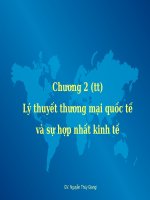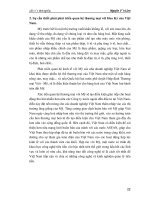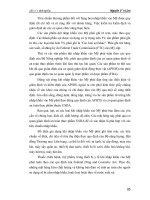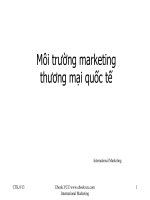Slide thương mại quốc tế it midterm
Bạn đang xem bản rút gọn của tài liệu. Xem và tải ngay bản đầy đủ của tài liệu tại đây (276.11 KB, 8 trang )
MID-TERM EXAM
International Trade (Time: 90 minutes)
Class: .....................................
Student name: ....................
ID: ...........................................
PART I: MULTIPLE CHOICE QUESTIONS (Circle the right answer) - 60 points
1. A primary reason why nations conduct international trade is because
A. Some nations prefer to produce one thing while others produce another
B. Resources are not equally distributed to all trading nations
C. Trade enhances opportunities to accumulate profits
D. Interest rates are not identical in all trading nations
2. International trade is narrowly defined as
A. The exchange of labor across national borders
B. The exchange of capital across national borders
C. The exchange of goods and services across national borders
D. The exchange of money across national borders
3. Re-export means
A. To export goods and services to a foreign country, going through a third
country
B. To export goods and services that have been imported from aboard
C. To export unprocessed goods and services to foreign countries
D. To export goods and services without doing export procedures out of
Vietnam
4. The source of beneficial free trade in the Ricardian world is
A. Comparative advantage based on different factor endowments
B. Comparative advantage based on different labor productivities
C. Economies of scale in production
D. Comparative advantage based on increasing returns to scale technology
5. According to the factor endowment model of Heckscher and Ohlin, countries heavily
endowed with land will
A. Devote excessive amounts of resources to agricultural production
B. Devote insufficient amounts of resources to agricultural production
C. Export products that are land-intensive
D. Import products that are land-intensive
6. The concept “terms of trade” means
A. The amount of exports sold by a country
B. The price conditions bargained for in international markets
CuuDuongThanCong.com
/>
C. The price of a country's exports divided by the price of its imports
D. The quantities of imports received in free trade
7. Export-biased growth in Home will
A. Improve the terms of trade of Home
B. Trigger anti-bias regulations of the WTO
C. Worsen the terms of trade of Foreign (the trade partner)
D. Improve the terms of trade of Foreign
8. How is an export subsidy by a large country different from an import quota by a
large country?
A. An export subsidy worsens terms of trade while an import quota
improves them
B. Unlike the welfare effects of an import quota, the welfare effects of an export
subsidy are ambiguous
C. An export subsidy improves terms of trade while an import quota worsens
them
D. They are not different The effects on income distribution are the same
9. If the tariff on computers is not changed, but the government then adds hitherto
nonexistent tariffs on imported semi-conductor components, then the effective rate
of protection in the computer industry will
A. Increase
B. Decrease
C. Remain the same
D. Depend on whether computers are personal computers or “Supercomputers”
10. Where there are economies of scale, an increase in the size of the market will
A. Increase the number of firms and raise the price per unit
B. Decrease the number of firms and raise the price per unit
C. Increase the number of firms and lower the price per unit
D. Decrease the number of firms and lower the price per unit
11. If Australia has more land per worker, and Belgium has more capital per worker,
then if trade were to open up between these two countries
A. Australia would export the land-intensive product
B. Belgium would import the capital-intensive product
C. Both countries would export some of each product
D. Trade would not continue since Belgium is a smaller country
12. According to the Standard Trade Model exposited in the text, the offer of a subsidy
on the export good by the Home country
A. Increase the relative supply of cloth from RSI to RS2
B. Reduces the relative demand of cloth from RD1 to RD2
C. The relative price of cloth and the terms of trade falls from (PC/PF)1 to
(PC/PF)2
CuuDuongThanCong.com
/>
D. All of the above
13. If, beginning from a free trade equilibrium, the terms of trade improve for a country,
then it will
A. Increase production of its import competing good
B. Increase consumption of its export good
C. Increase the quantity of its imports
D. Experience an export-biased shift in its production possibility frontier
14. An important difference between tariffs and quotas is that tariffs
A. Raise the price of the good
B. Generate tax revenue for the government
C. Stimulate international trade
D. Help domestic producers
15. If Pc/Pf were to increase in the international marketplace, then
A. All countries would be better off
B. The terms of trade of cloth exporters improve
C. The terms of trade of food exporters improve
D. The terms of trade of all countries improve
16. A large country experiencing import-biased economic growth will tend to
experience
A. Positive terms of trade
B. Deteriorating terms of trade
C. Improving terms of trade
D. Immiserizing terms of trade
17. External economies of scale arise when the cost per unit
A. Rises as the industry grows larger
B. Falls as the industry grows largerrises as the average firm grows larger
C. Falls as the average firm grows larger
D. Remains constant
18. Intra-industry trade will tend to dominate trade flows when which of the following
exists?
A. Large differences between relative country factor availabilities
B. Small differences between relative country factor availabilities
C. Homogeneous products that cannot be differentiated
D. Constant cost industries
19. A tax of 20 cents per unit of imported garlic is an example of a(n)
A. Specific tariff
B. Ad valorem tariff
C. Nominal tariff
D. Effective protection tariff
CuuDuongThanCong.com
/>
20. An industry is characterized by scale economies and exists in two countries. In
order for consumers of its products to enjoy both lower prices and more variety of
choice
A. Each country's marginal cost must equal that of the other country
B. The marginal cost of this industry must equal marginal revenue in the other
C. The monopoly must lower prices in order to sell more
D. The two countries must engage in international trade one with the
other
21. If a good is imported into a (large) country H from country F, then the imposition of
a tariff in country H
A. Raises the price of the good in both countries
B. Raises the price in country H and cannot affect its price in country F
C. Lowers the price of the good in both countries
D. Raises the price of the good in H and lowers it in F
22. The imposition of a tariff on imported good by a small country results in net
national welfare loss because of the
A. Loss in consumer surplus exceeds gain in producer surplus
B. Efficiency losses due to production and consumption distortions
C. Loss in consumer surplus exceeds gain in government revenue
D. Efficiency loss due to production and consumption distortions exceed the
terms of trade gain
23. In the exporting country, an export subsidy will
A. Help consumers and raise the overall economic welfare of the exporting
country
B. Hurt consumers but raise the overall economic welfare of the exporting
country
C. Hurt consumers and lower the overall economic welfare of the
exporting country
D. Help consumers but lower economic welfare of the exporting country
24. Where there are economies of scale, an increase in the size of the market will
A. Increase the number of firms and raise the price per unit
B. Decrease the number of firms and raise the price per unit
C. Increase the number of firms and lower the price per unit
D. Decrease the number of firms and lower the price per unit
25. Internal economies of scale
A. May be associated with a perfectly competitive industry
B. Cannot be associated with a perfectly competitive industry
C. Are associated only with sophisticated products such as aircraft
D. Cannot form the basis for international trade
CuuDuongThanCong.com
/>
26. Consider Peru and Argentina in a Ricardian world. Each country produces two
goods, Corn and Wheat. Each country has 600 units of labor hour available. The
table of unit labor costs for production of each good in each country is below
Corn
2
1
Peru
Argentina
Wheat
6
4
If world relative price for wheat is 3.5, then
A.
B.
C.
D.
Relative quantity of wheat supplied is 6
The world relative quantity of wheat supplied is 1/2
The world relative quantity of wheat supplied is 1/6
The world relative quantity cannot be determined from the information
given
27. Which of the following is NOT true about the import demand curve?
A. It is steeper than the domestic demand curve in the importing country
B. It is flatter than the domestic demand curve in the importing country
C. It slopes down
D. It intersects the vertical axis at the domestic equilibrium price in autarky
equilibrium
28. Which of the following is NOT true about the export supply curve?
A. It intersects the vertical axis at the foreign equilibrium price in autarky
equilibrium
B. It is steeper than the domestic supply curve in the exporting country
C. It is flatter than the domestic supply curve in the exporting country
D. It describes the excess of foreign supply over foreign demand
29. Suppose that there are two factors, capital and land, and that the United States is
relatively land endowed while the European Union is relatively capital-endowed.
According to the Heckscher-Ohlin model
A. European landowners should support US-European free trade
B. European capitalists should support US-European free trade
C. All capitalists in both countries should support free trade
D. All landowners should support free trade
30. Those who stand to gain from trade
A. Do not really care about the issue of income redistribution
B. Could not compensate losers since there are so many poor people
C. Could compensate losers but would rather not in modern industrial
economies
CuuDuongThanCong.com
/>
D. Compensate losers at least partially through such legislation as
unemployment compensation
31. When a government allows raw materials and other intermediate products to enter
a country duty free, this generally results in a(an)
A. Effective tariff rate less than the nominal tariff rate
B. Nominal tariff rate less than the effective tariff rate
C. Rise in both nominal and effective tariff rates
D. Fall in both nominal and effective tariff rates
32. According to the factor price equalization theorem, the owners of ________ factor
should oppose free trade policies in any given country
A. Abundant
B. Scarce
C. Neither
D. Can’t tell without more information
33. Which of the following will be the lowest barrier on imports of $300 digital
cameras?
A. An ad-valorem 5% tariff
B. A specific $10 tariff
C. A quota that raises the internal price of the cameras by 5%
D. A compound duty of $5 and 1%
34. If some industries exhibit internal (firm specific) increasing returns to scale in each
country, we should not expect to see
A. Intra-industry trade between countries
B. Perfect competition in these industries
C. Inter-industry trade between countries
D. High levels of specialization in both countries
35. An import tariff of $10 per unit of imported good imposed by a large country
A. Increases the price of this good in the importing country by less than
$10 and lowers export prices
B. Increases the price of this good in the importing country by more than $10
and raises export prices
C. Increases the price of this good in the importing country by $10 and leaves
export prices unaffected
D. Increases the volume of exports of that good by foreigners
36. A Vietnamese shoe company imports all materials used to produce shoes from a
Taiwanese company. It uses all of those materials to produce shoes and then exports
back finished shoes to that Taiwanese company. This transaction is considered as
A. International processing
B. Re-export
C. Export
CuuDuongThanCong.com
/>
D. Switch trade
37. During the 19th Century, economic growth of the major trading countries was
biased toward manufactures away from food. The less developed countries of that
time were net exporters of food. From this information, we would expect to have
observed
A. Falling terms of trade for the less developed countries
B. Improving (rising) terms of trade for the less developed countries
C. No change at all in the terms of trade of the less developed countries
D. A decrease in the relative price of food
38. Intra-industry trade will tend to dominate trade flows when which of the following
exists?
A. Large differences between relative country factor availabilities
B. Small differences between relative country factor availabilities
C. Homogeneous products that cannot be differentiated
D. Constant cost industry
39. If Slovenia is a small country in world trade terms, then if it imposes a large series of
tariffs on many of its imports, this would
A. Have no effect on its terms of trade
B. Improve its terms of trade
C. Deteriorate its terms of trade
D. Decrease its marginal propensity to consume
40. The two country, multi-good model differs from the two country, two product model
in that in the former
A. The relative wage ratio will determine the pattern of trade (which good is
exported by which country)
B. One cannot determine which country will export which product given only
labor productivity data
C. Full specialization is less likely to hold in equilibrium
D. All of the above
PART II: SHORT ESSAYS (40 points)
Choose ONE over FOUR questions
1. Some argue that tariffs always hurt the imposing country's economic welfare, and
are typically designed to shift resources from one sector to another, protected or
preferred one, within an economy. Find and discuss a counterexample to this
argument
2. Explain why the production distortion is indeed a loss to society when a country
imposes a tariff
3. It is argued that a tariff may help promote employment in a single industry, but is
not likely to help employment in general. Explain and give example
CuuDuongThanCong.com
/>
4. Evaluate the relative importance of economies of scale and comparative advantage
in causing the following
A. Half of the world’s large jet aircraft are assembled in Seattle
B. Most semiconductors are manufactured in either the United States or Japan
C. Most Scotch whiskey comes from Scotland
D. Much of the world’s best wine comes from France
CuuDuongThanCong.com
/>









